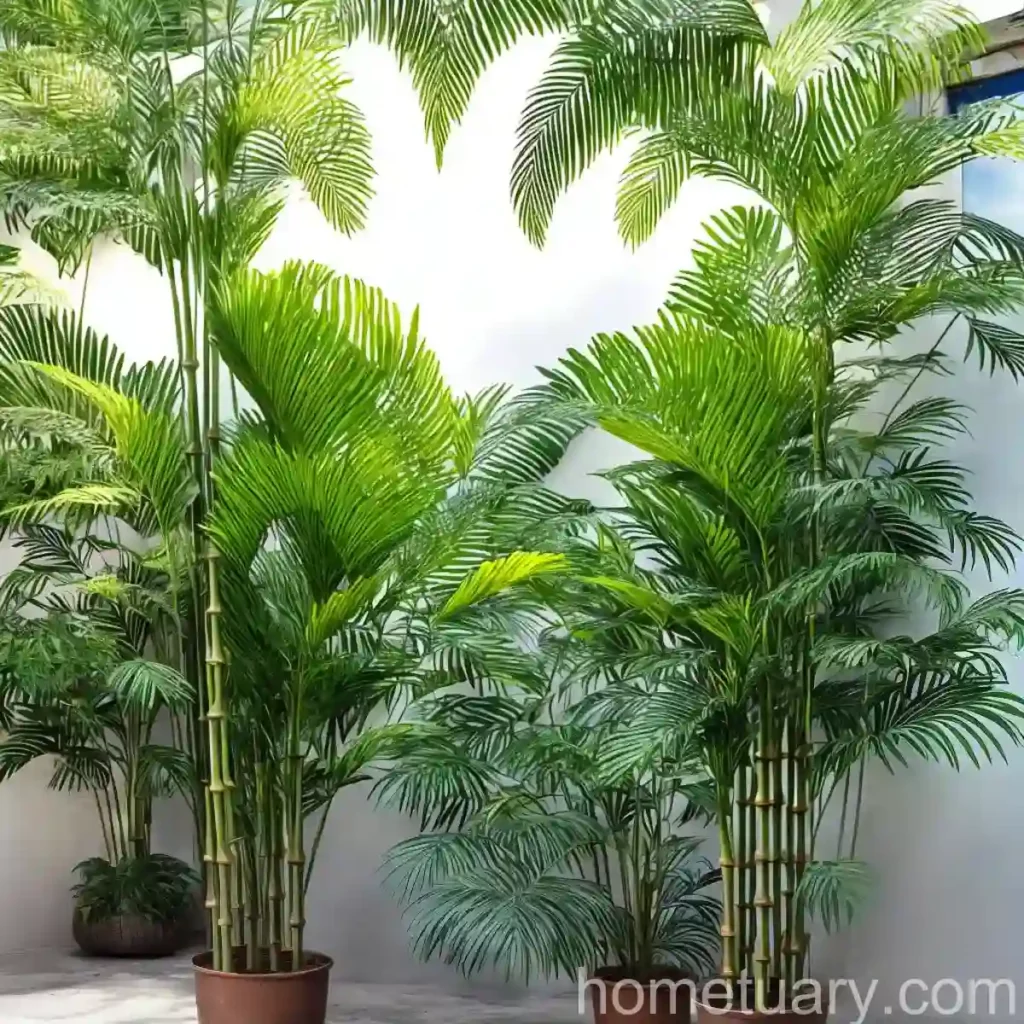The Amazing Bamboo Palm (Chamaedorea seifrizii)
Plants play an essential role in our lives, providing us with oxygen, food, and beauty. Having plants in our surroundings has been linked to reduced stress, improved air quality, and increased productivity. One captivating plant that is gaining popularity for its elegant appearance and air-purifying qualities is the bamboo palm (Chamaedorea seifrizii). In this comprehensive guide, we will delve into the world of bamboo palm, exploring its characteristics, care requirements, uses, and much more.
What is the Bamboo Palm (Chamaedorea seifrizii)?
The bamboo palm, scientifically known as Chamaedorea seifrizii, is a tropical plant belonging to the family Arecaceae. It is native to the rainforests of Southern Mexico and Guatemala, where it thrives in the warm, humid climate under the canopy of larger trees. Also referred to as the reed palm or the lady palm, the bamboo palm is appreciated for its slender, cane-like stems and delicate, feathery fronds. As an adaptable and low-maintenance plant, it has become a popular choice for indoor and outdoor settings.
Key Takeaways – Bamboo Palm (Chamaedorea seifrizii)
Culture
- Scientific Name: Chamaedorea seifrizii
- Common Names: Bamboo Palm, Reed Palm, Lady Palm
- Family: Arecaceae
- Origin: Southern Mexico, Guatemala
- Type: Tropical, Evergreen
Uses
- Indoor Plant: Excellent for adding a touch of greenery to interior spaces.
- Air Purification: Known for its ability to remove toxins from the air, enhancing indoor air quality.
- Decorative Plant: Adds a tropical and soothing ambiance to homes, offices, and public spaces.
Now, let’s explore the essential care requirements for ensuring the health and vitality of the bamboo palm.
Bamboo Palm Care
Water
Proper watering is crucial for maintaining a healthy bamboo palm. It is important to keep the soil consistently moist but not waterlogged. Here are some key watering tips:
- Frequency: Water the plant when the top inch of the soil feels slightly dry to the touch.
- Watering Method: Ensure thorough watering, allowing excess water to drain from the bottom of the pot.
- Avoid Overwatering: Do not let the plant sit in standing water, as this can lead to root rot.
Sunlight
The bamboo palm thrives in bright, indirect light. While it can tolerate lower light conditions, it may not grow as vigorously. Consider the following sunlight requirements:
- Ideal Location: Place the plant in a location with bright, filtered light, such as near a window with sheer curtains.
- Avoid Direct Sun: Protect the plant from direct sunlight, especially during the hottest part of the day.
Fertilizer
Proper fertilization can encourage healthy growth and vibrant foliage in the bamboo palm. Use a balanced, water-soluble fertilizer formulated for indoor plants. Here are some fertilizer application tips:
- Frequency: Apply fertilizer every 2-4 weeks during the growing season (spring and summer).
- Dilution: Follow the instructions on the fertilizer packaging for proper dilution.
- Avoid Overfeeding: Excessive fertilizer can result in salt build-up in the soil, causing damage to the plant.
Soil
Well-draining, nutrient-rich soil is essential for the bamboo palm to thrive. Prepare a suitable potting mix by combining the following components:
- Ingredients: Use a mix of peat moss, perlite, and pine bark for a loose, well-aerated soil blend.
- Benefits: This type of soil allows for proper root growth and prevents waterlogging.
Pruning
Regular pruning helps maintain the bamboo palm’s attractive appearance and promotes healthy growth. Follow these pruning guidelines:
- Remove Yellowed Fronds: Trim yellow or brown fronds at the base of the plant to enhance its aesthetic appeal.
- Prune Cane Stems: If necessary, trim any damaged or unsightly cane stems at the base using sharp, clean pruning shears.
Propagation
While bamboo palms are primarily propagated from seeds, they can also be propagated by division. Here’s how to propagate a bamboo palm through division:
- Select a Healthy Plant: Choose a mature, healthy plant for division.
- Carefully Divide the Rootball: Gently separate the rootball into sections, ensuring that each section has healthy roots and several stems.
- Replant the Divisions: Plant each division in its own pot with suitable soil, and water thoroughly.
Container
When selecting a container for your bamboo palm, consider the following factors:
- Size: Choose a container that provides ample room for the plant’s roots to grow without being excessively large.
- Drainage Holes: Ensure that the container has drainage holes to prevent water from accumulating at the bottom.
Popularity
The bamboo palm’s popularity stems from its numerous advantages as an indoor plant. Here are a few reasons why this tropical beauty has captured the hearts of plant enthusiasts:
- Aesthetic Appeal: The graceful, arching fronds and slender stems make the bamboo palm an elegant addition to any space.
- Air-Purifying Qualities: Research has shown that the bamboo palm effectively removes indoor air pollutants, contributing to a healthier environment.
- Low-Maintenance: Its resilience and adaptability make it an ideal choice for both novice and experienced plant owners.
With its growing popularity, the bamboo palm has found its way into various settings, from homes and offices to retail spaces and hotels.
Common Diseases
Like any plant, the bamboo palm is susceptible to certain diseases. Being aware of common diseases and their symptoms can help in early detection and effective treatment. Here are some common diseases that can affect the bamboo palm:
- Root Rot: Overwatering or poor drainage can lead to root rot, causing the plant’s roots to become mushy and discolored.
- Leaf Spot: Fungal infections can cause dark spots or lesions on the plant’s fronds, leading to deterioration.
- Pest Infestations: Pests such as spider mites and scale insects can affect the bamboo palm, causing damage to the foliage.
Disease Diagnosis
Prompt identification of diseases is important for preventing their spread and protecting the plant’s health. If you notice any unusual symptoms, such as wilting, discoloration, or unusual spots on the leaves, take the following steps:
- Inspect the Plant: Carefully examine the plant, focusing on the leaves, stems, and soil.
- Research Symptoms: Use reliable resources to identify the cause of the symptoms and determine the appropriate course of action.
- Isolate the Plant: If a disease is suspected, isolate the affected plant to prevent the spread of the infection to other plants.
Common Pests
Pests can pose a threat to the health of the bamboo palm if left unchecked. Here are some common pests that can target this tropical beauty:
- Spider Mites: These tiny pests can cause stippling on the leaves and create fine webbing on the plant.
- Scale Insects: Scale insects can attach themselves to the stems and fronds, feeding on the plant’s juices and causing yellowing or wilting.
- Mealybugs: These soft-bodied insects can cluster on the undersides of the leaves, sucking sap from the plant and causing stunted growth.
Botanist’s Tips
As a plant scientist with a passion for tropical flora, I recommend the following tips for maintaining a thriving bamboo palm:
- Monitor Moisture Levels: Keep a close eye on the plant’s watering needs, adjusting the frequency and amount based on environmental conditions.
- Regular Maintenance: Schedule regular pruning and cleaning of the plant to promote air circulation and discourage pest infestations.
- Growth Observations: Observe the growth patterns of the bamboo palm, paying attention to any changes in leaf color, frond development, or overall vigor.
Fun Facts
To deepen your appreciation for the bamboo palm, here are some delightful fun facts about this captivating plant:
- Tropical Origins: The bamboo palm’s native habitat of lush, tropical rainforests inspires a sense of wanderlust and natural beauty.
- Architectural Appeal: Its graceful form and slender stems make the bamboo palm a favorite choice for enhancing architectural spaces.
- Wildlife Habitat: In its natural environment, the bamboo palm provides shelter and sustenance for various wildlife species, contributing to the ecological balance.
As a beautiful and beneficial plant with tropical origins, the bamboo palm has much to offer in terms of aesthetics, functionality, and environmental benefits.
Links to External Resources
For further information on the bamboo palm, its care, and its benefits, explore the following resources:
- The Spruce – How to Care for a Parlor Palm
- Gardening Know How – Bamboo Palm Care
- HGTV – Bamboo Palm Care and Growing Guide
- The Sill – Bamboo Palm Plant Care
- Plant Care Today – How to Grow Chamaedorea Seifrizii Indoors
In conclusion, the bamboo palm, with its graceful appearance and air-purifying qualities, has rightfully earned its place as a beloved tropical plant. By understanding its care requirements and value as a decorative and beneficial plant, we can continue to enjoy the many benefits it offers. Whether it’s adding a touch of green to our homes, purifying the air we breathe, or simply marveling at its natural beauty, the bamboo palm has certainly made its mark in the world of indoor plants.
Remember, caring for your bamboo palm goes beyond routine maintenance – it’s a way to connect with nature and cultivate a thriving, green sanctuary within your living space. I hope this comprehensive guide has provided you with valuable insights and inspiration for nurturing your own bamboo palm with confidence and joy.
Happy growing!















